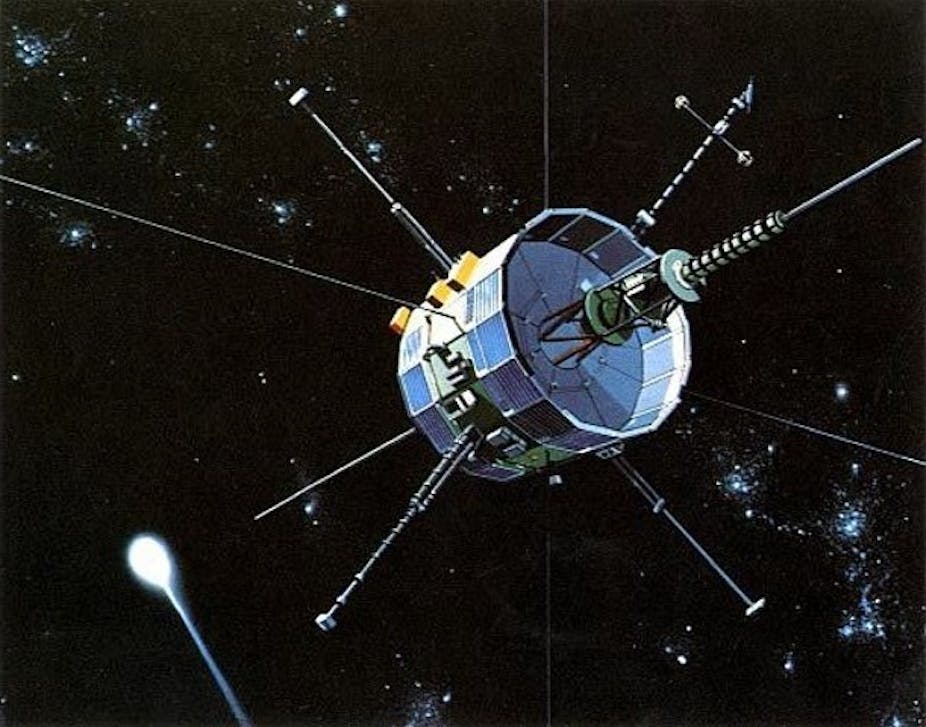For decades, space exploration remained a domain within reach of only government agencies, who could command huge pools of expertise and public funds. Now the means by which our space endeavours are funded have become more diverse, and more and more private space initiatives are appearing.
NASA recently awarded contracts to two private companies, SpaceX and Boeing, to build the spacecraft that will ferry astronauts to and from the International Space Station. Commercial space tourism, however high-end a proposition it is now, is set to expand. And similar developments are occurring in the field of unmanned spaceflight: Planetary Resources, Inc has the ambitious aim of mining asteroids for minerals.
The age of commercial, private, space adventurism is here.
The latest and perhaps most inspiring example is the crowd-funded project to resurrect a decades-old NASA spacecraft purely for the engineering challenge and science potential. The International Sun-Earth Explorer 3 unmanned probe (ISEE-3) was launched by NASA in 1978 to study the flow of particles from the Sun that buffet the Earth’s magnetic field, known as the solar wind. Dispatched to a location between the Sun and Earth where the gravitational pull of our planet and the Sun cancel each other, the spacecraft spent years carrying out its task.
ISEE-3, the little spaceship that could
In the early 1980s, with Halley’s Comet rapidly approaching, NASA was conspicuous by its absence among the international flotilla of spacecraft being assembled to investigate this most famous of comets up close.
Bob Farquhar and the team running ISEE-3 hatched an audacious plan, making the most of ISEE-3’s remaining fuel to perform some complex manoeuvring through a series of changes in orbit and the slingshot effect of the moon, sending it far from Earth. On its new course, ISEE-3 would encounter the smaller Comet 21P/Giacobini-Zinner, beating the international armada heading for Halley by several months. As the temporarily renamed International Cometary Explorer (ICE), it conducted the first-ever comet encounter in September 1985, and was then left to drift in an orbit that would bring it back towards Earth in 2014.

Although NASA had occasionally checked on the spacecraft’s health (most recently in 2008), it was clear that the agency did not place a high priority on resurrecting it. Many enthusiasts and scientists – including Farquhar himself, now long retired – were concerned that this pioneering probe was going to be abandoned, when it could in principle be returned to its spot between the Sun and Earth to perform further solar wind observations or, if enough fuel remained, to even encounter a second comet in 2017 or 2018.
Interplanetary boarding
In the 29 years since ISEE-3’s first comet encounter, there have been terrific advances in access to large dishes and radio communications hardware. So it was not hard even for groups of amateur enthusiasts to try and contact ISEE-3. Radio signals from the spacecraft were detected by a German group in March 2014, indicating that it was still operational after 36 years in space.
A small group of enthusiasts, who had previously reprocessed, in better quality, the images sent back from the 1960s Lunar Orbiter programme, through a privately-funded project, were keen to try and bring ISEE-3 back under control. They set up a crowd-funding site to raise the necessary funds; donations rolled in, eventually reaching almost US$160,000, together with offers of technical assistance and long-lost documentation for the probe.
Using the Arecibo radio telescope in Puerto Rico, commands were sent to the probe, and on May 29 those attempts bore fruit – the ISEE-3 Reboot Project became the first non-governmental organisation to command a spacecraft in interplanetary space.
In early July, ISEE-3’s thrusters were commanded back to life, bringing the spacecraft’s rate of spin under control. A few days later, further thruster commands didn’t go as well – although carrying enough fuel, the nitrogen gas required to provide pressure to the thruster system had apparently leaked away. The Reboot Project team had to reluctantly conclude that the spacecraft was showing its age and that returning it to orbit would be impossible.
Re-using spaceships for fun and profit
Despite problems controlling the spacecraft’s path, power levels were good, with the solar panels performing well. Data returned from the craft’s scientific instruments were excellent, revealing features in the solar wind and the signatures of solar flares.
On August 10, ISEE-3 sailed past the moon. Its instrument data complemented observations made by two other spacecraft in lunar orbit that had themselves been repurposed from the NASA THEMIS mission. The readings taken by ISEE-3 are posted online as open data for anyone to study. The last was heard from ISEE-3 on September 16; since then, there has been silence. It’s likely that ISEE-3 has switched to safe mode, turning off its transmitters and instruments, and it’s unclear whether the probe can be woken before it again leaves the Earth’s vicinity for the cold depths of space.
Although ultimately short-lived, the ISEE-3 project demonstrated the enthusiasm and resources available for private space endeavours. What other projects might follow? The sky is the limit – perhaps even involving the three lunar rovers sitting on the moon since the early 1970s. Only new batteries are needed to bring them back to life, so perhaps well-funded space tourists will, in a few decades, be able to not just fly to the moon but drive on it when they get there.

